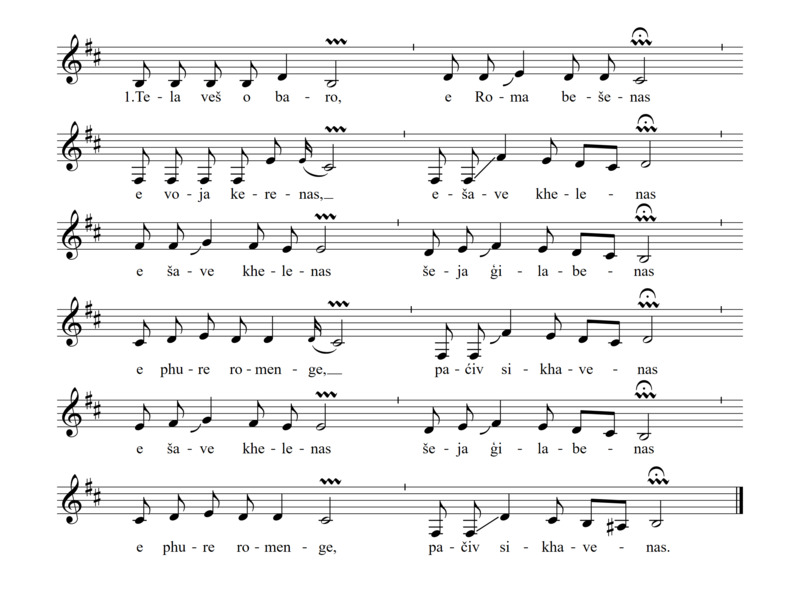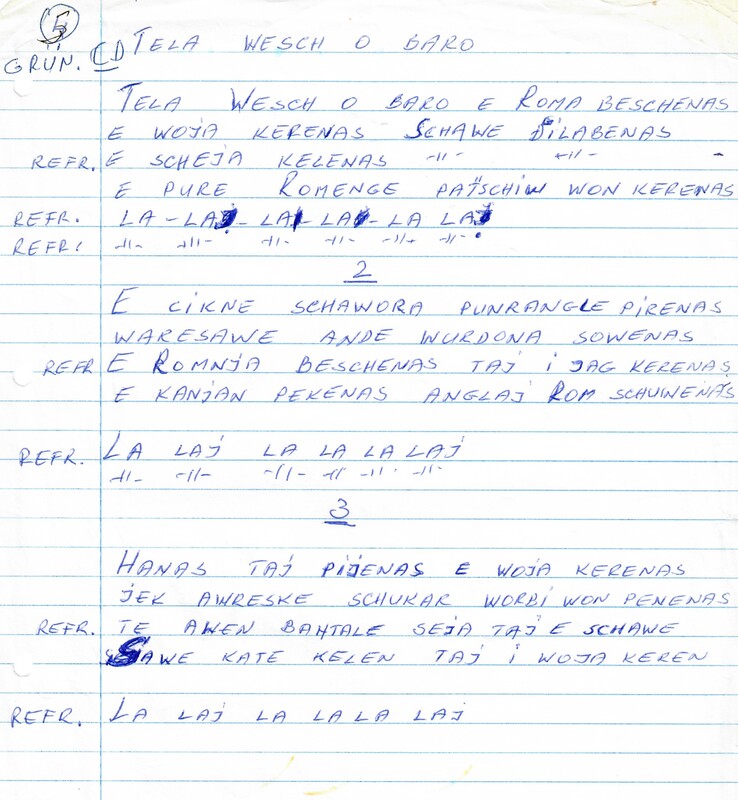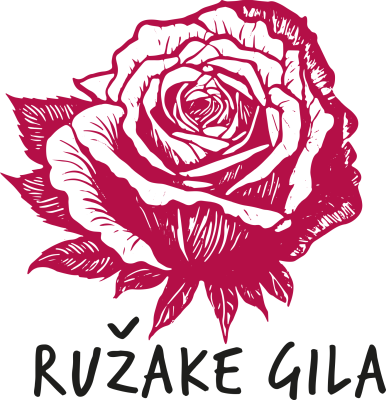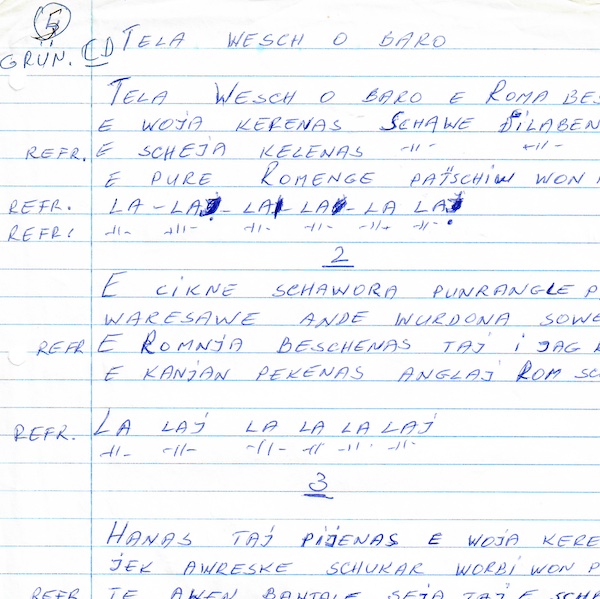
Tela veš o baro
Content
Recordings
Tela veš o baro belongs to the neve gila, the new songs, and was written by Ruža Nikolić-Lakatos and Mišo Nikolić. The text is about a harmonic scene from traditional Romani life. This is the free-rhythmic, older version of the song. The recording was made in 1993 at the Nikolić family home.
Musical transcription based on the booklet accompanying the CD Amare gila - Unsere Lieder / Our Songs
Ruža Nikolić-Lakatos originally sang Tela veš o baro in the slow, free-rhythmical version. Together with her family, The Gypsy Family, she adapted the song to a faster version a few years later. The reason for this was to adapt it to the non-Roma audience, who do not understand the Romani language. Ethnomusicologist Ursula Hemetek explains:
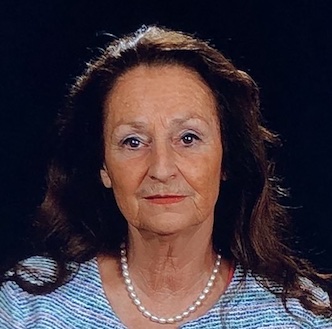
„There are various reasons for the musical change within eight years. One of the most important is that Ruža first started singing for non-Roma audiences in 1989 and that the change in the audience has led to a change in style. In the past she could assume that every word of her songs would be understood by the audience and that the listeners could also adequately enter a process of interaction with the culture by entering into a dialogue with her, today there are mainly people in the audience who do not understand a word. Since interaction with the audience is still an important performance factor for Ruža, she had to find ways and means to overcome this 'inability' of the audience. If you want an Austrian audience to sing along, you can't do it in the Romani language, you have to use neutral syllables. You can also get the audience to dance along if you use a simple rhythm. [...] In between lies the time of musical 'renewal' due to the demands of the audience, but also because the younger generation, namely Ruža's sons, who have been playing in the ensemble since 1994, have had significant felt.“
The researcher also reflects on the stylistic differences between the two Tela veš o baro versions and the reaction of the audience:

„While the first version is realised in the style of loke gila, slow songs, free-rhythmical and with long line-ending notes with vibrato, in the second version it becomes a dance song. 2/4 or 4/4 measure is underlaid, whereby the melody, which contains the same pitches, is adapted to this rhythm. The 'beat' is realized by a synthesizer. A new addition is the refrain with 'la la la la la la la', which did not exist in the old version. It is there to actively involve the audience in the singing, and it works very well most of the time. This new version is quite creative and meets the requirements of an audience that doesn't understand a word and feels 'at home' thanks to the catchy minor melody and the familiar 2/4 or 4/4 measure signature.“
Source:
- Hemetek, Ursula. (2005). „The 'Own' and the 'Foreign' based on the Minority Focus of the Institute for Folk Music Research and Ethnomusicology.“ In: Grupe, Gerd (ed.), Music Ethnology and Folk Music Research in Austria: The 'Foreign' and the 'Own'? Aachen: Shaker Verlag, 2005. pp. 117-135.
After a few years, Ruža Nikolić-Lakatos and The Gypsy Family created a fast, rhythmic version of Tela veš o baro. A chorus with the lyrics consisting of "la la la" was added so that a non-Roma audience could sing and dance along. The verses are identical to the earlier version. The recording dates from 2001 and was made during a performance at the Interkulttheater.
Ruža Nikolić-Lakatos and The Gypsy Family published this version of Tela veš o baro on their CD E Trin Worbi.
Commentary
(GERMAN ONLY) Ruža Nikolić-Lakatos and Mišo Nikolić explain the genesis and content of Tela veš o baro as part of a performance for the event series Reisende auf dieser Welt at the Amerlinghaus in 1993. Ruža emphasises that a typical scene from the traditional life of the Roma is described.
(GERMAN ONLY) Ethnomusicologist Ursula Hemetek introduces Tela veš o baro during a performance at the Interkulttheater in 1993. She emphasises that Ruža Nikolić-Lakatos and Mišo Nikolić are a very inspired couple and create about two new songs a week together. She comments on the process of creating these neve gila, new songs, and emphasises that Mišo's poetic texts in the Romani language can only be insufficiently translated into German.
Lyrics
Stanza 1
| Tela veš o baro e Roma bešenas, | The Roma were camped at the edge of a large forest. |
| e voja kerenas, e šave khelenas. | They talked, the boys danced. |
| |: E šave khelenas, šeja gjilabenas, | |: The boys danced, the girls sang, |
| e phure Romenge patjiv sikhavenas :|. | and they paid homage to the elderly :|. |
Stanza 2
| E cigne šavora punranges phirenas, | The small children ran barefoot, |
| varisave ande vurdona sovenas, | and some slept in the wagons, |
| |: e Romnja bešenas taj i jag kerenas, | |: The women sat and made a fire. |
| e khajnjan pekenas, anglaj Rom šuvenas :|. | They roasted and served chicken to the men :|. |
Stanza 3
| Xanas taj pijenas, e voja kerenas, | They ate and drank and gave each other joy. |
| jek avrenge šukar vorbi von phenenas: | They said beautiful words to each other: |
| |: Te aven baxtale, šeja taj e šave | |:Be happy, girls and boys, |
| save kate khelen taj i voja keren :|. | who dance and celebrate :|. |
Manuscript by Mišo Nikolić
Video
Ruža Nikolić-Lakatos and The Gypsy Family perform Tela veš o baro in the modern version on the occasion of Dieter Berner's birthday party in 2014. Ruža Nikolić-Lakatos became acquainted with the film director when she appeared in a guest role for the crime series "Tatort" (first broadcast in 2005). The video shows the exuberant mood of the party. The video is a private recording by Ursula Hemetek.
Zitierempfehlung anzeigen
Bitte zitieren Sie diese Seite wie folgt:
Music and Minorities Research Center, "Tela veš o baro", Ružake gila, zuletzt besucht am Loading date..., doi.org/10.21939/jf6a-dx21

